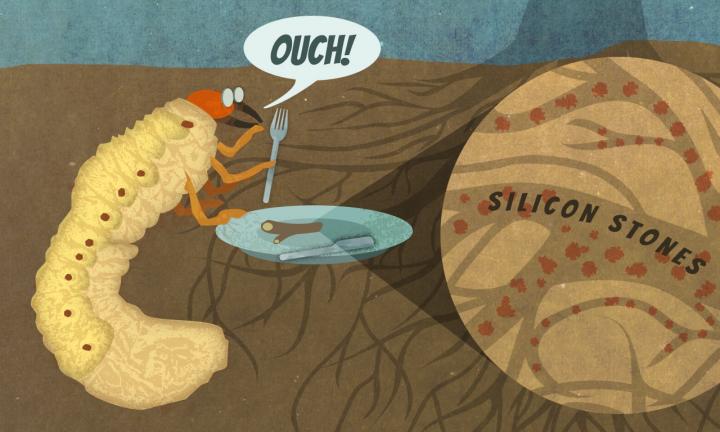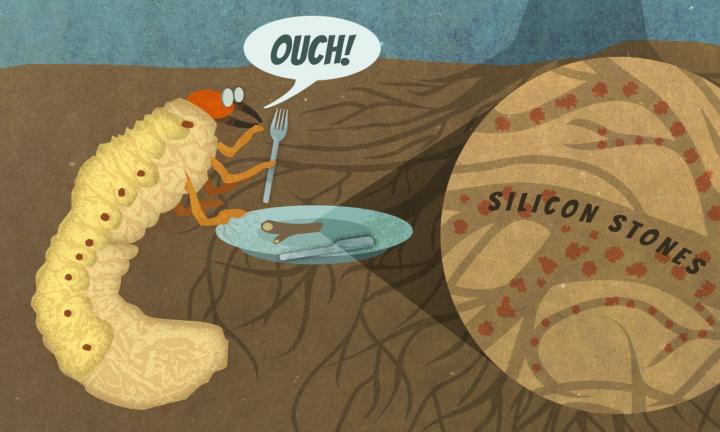
Credit: Illustration by Jeff Chase/ University of Delaware
To help plants better fend off insect pests, researchers are arming them with stones.
The University of Delaware's Ivan Hiltpold and researchers from the Hawkesbury Institute for the Environment at Western Sydney University in Australia are examining the addition of silicon to the soil in which plants are grown to help strengthen plants against potential predators.
The research was published recently in the journal Soil Biology and Biochemistry and was funded by Sugar Research Australia. Adam Frew, currently a postdoctoral research fellow at the Charles Sturt University in Australia, is the lead author on the paper.
Hiltpold, assistant professor of entomology and wildlife ecology in UD's College of Agriculture and Natural Resources, said the basis of the project was to assess the impact of arbuscular mycorrhizal fungi on a plant's nutritional quality and also on root pests, using sugar cane and root-feeding insects, primarily cane grubs–the voracious larvae of the cane beetle.
"This research demonstrated a cascading effect," said Hiltpold. "We have silicon and other plant nutrients in the soil, we have the fungi that is interacting with the plant and metabolites, and all that plant chemistry has an impact on insect development."
Silicon is the world's second most abundant element after oxygen in the Earth's crust, but because it is in a stone or mineral form, it is not readily available for use by plants.
By amending the soil with silica, a form of silicon that plants can easily take up, the researchers helped the plants build up tiny particles called phytoliths, or "plant stones," to defend against herbivorous insects and possibly rodents.
"The plant builds up these sorts of stones in its tissues, which will reduce the digestibility of the plant material because digesting stones is not very easy," said Hiltpold. "Also, these stones wear the mouth parts of insects and possibly rodents. If your teeth are not really cutting any more, then you cannot eat as much as you could. All of that added together will reduce the impact of herbivory on the plant."
In experiments with two sugarcane varieties grown in a greenhouse, root-feeding insects, primarily the cane grub, fed on the plants. The immune function of the insects was assessed by measuring their immune response to entomopathogenic nematodes–small organisms that kill insects in the soil–while insect growth and root consumption were assessed in a feeding trial.
The researchers found that high levels of silicon concentrations decreased insect growth and root consumption, the latter by 71 percent.
Because the silicon doesn't affect grazing livestock, Hiltpold said that it also will not affect humans when, for example, a person consumes boiled carrots or sweet corn.
Hiltpold said they chose the cane grub for their study because it is a major pest in Australia.
"Sugar cane is a big industry in Australia, and these larvae are really causing a lot of damage to it. These grubs can be pretty big–their diameter can be as big as my thumb," Hiltpold said. "As soil pests, they are really hard to control because they are hard to reach with insecticides and they are hard to monitor. We don't really know where they are before we see the damage on the plant, and then usually it's too late. Having options to control them is always good."
The option of using silicon to naturally strengthen the plant's defenses against the cane grub would be both environmentally friendly and economically attractive to growers, as they would not have to spray as much to protect their crops.
"The idea of amending crops with silicon in general is that, OK, we have this element that is naturally present. The only thing is that it's not bio-available so it cannot be taken up by the plant as is, but if we add a little bit of bioavailable silicon to the field, then it boosts the plant's biomass," said Hiltpold. "The plant productivity is increased and also the plant defenses are increased because the silicon accumulates in the tissue above and below ground and helps the plants to cope with insect as well as mammal herbivory."
Hiltpold said this research could be applicable to other types of plants besides sugarcane.
He also said that in addition to the plants' interaction with the silicon, the fungi had a surprising impact on the insects.
"We don't exactly know if it's via the plant or directly from the exposure to the fungi, but the insect immune system was triggered when the plants were treated with the fungi," said Hiltpold. "That could be useful in an integrated management view because triggering an immune system if there is no invader, no pathogen exposure, might have a cost on the growth or performance of the insect, so that will eventually have a beneficial impact on the plant because the insect is doing less well and doing less damage. I think that was an interesting finding that was never demonstrated before."
###
Media Contact
Peter Bothum
[email protected]
302-831-1418
@UDResearch
http://www.udel.edu





